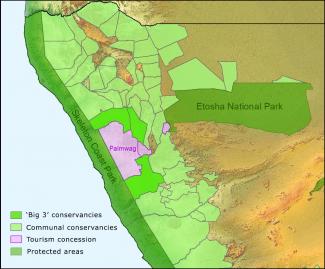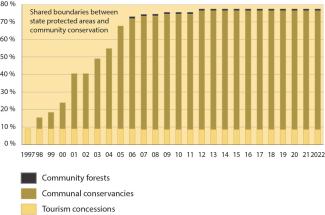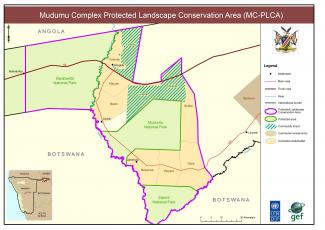Very large contiguous areas under sustainable resource management have been created within Namibia. The largest contiguous area is found in the northwest, where conservancies and tourism concession areas now adjoin the entire eastern boundary of the Skeleton Coast Park and form a broad link to Etosha National Park through connections with conservancies. This is particularly important in this arid environment, as animals need to be able to move in response to both dry and moist conditions to find adequate forage to survive.
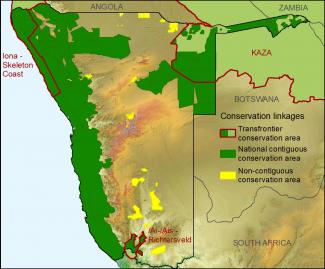
The contiguous areas under sustainable natural resource management including state protected areas, freehold and communal conservancies and community forests. In addition to the vast areas created within Namibia, important transboundary linkages have also been created with the Iona/ Skeleton Coast, KAZA and |Ai-|Ais/Richtersveld transboundary conservation areas.
| Contiguous area (excludes transfrontier linkages) | State protected areas | Community conservation/concessions | Private reserves |
|---|---|---|---|
| 1. Coastal parks, Ai-Ais & Etosha NP | 124,869 | 94,249 | 2,886 |
| 2. Waterberg, Khaudum NP | 4,238 | 59,943 | 0 |
| 3. Bwabwata, Mudumu, Mamili | 7,330 | 1,956 | 0 |
| Total area (km2) | 136,437 | 156,148 | 2,886 |
National and international shared boundaries
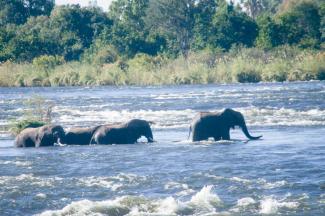
Increase in shared boundaries in Namibia
Conservation complexes
Complexes are mixed conservation areas comprising national parks, conservancies and forest areas under joint management, led by the MEFT. A number of conservancies and community forests are forming joint management complexes with national parks, to enable more effective management of resources and activities at a larger landscape level. The Mudumu Complex, the Khaudum North Complex and the Greater Waterberg Complex are examples.
The institutional structures consist of representatives from the MEFT, conservancies, community forests, and may include the private sector. The forums also have representation from support sectors such as agriculture, police, the defence force, local government, water affairs, traditional authorities and NGOs.
Joint management forums of national parks and conservation areas in complexes allow collaborative landscape level management and planning, including the effective management of mobile wildlife populations, more efficient anti-poaching activities, and fire management. Complexes remove barriers to connectivity and generate economies of scale for investments and enterprise opportunities.
Tourism concessions
Previous hunting concessions on state land have been re-designated as tourism concessions where hunting of any form is not allowed. The MEFT has granted concession rights to conservancies adjacent to tourism concessions, which increases both the contiguous area under conservation, benefiting wildlife, and the income to conservancies derived through tourism.
Palmwag is the largest tourism concession, where rhino, elephant and plains game are protected. The well-known Palmwag Lodge, at the intersection of two major tourism routes, is a joint-venture between a private sector investor and three conservancies adjacent to the concession, Anabeb, Torra and Sesfontein, known as the 'Big 3'.
Tourism concessions inside national parks have been granted to conservancies adjacent to parks, allowing conservancies to operate tours within the parks, and in some instances to operate lodges within the parks. The conservancy and park areas are contiguous.
